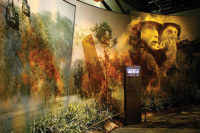This title says it all, basically. I say this about five times a day to clients wanting to know how to soundproof and the question invariably that comes back is: “Why not? Then what the heck is it used for, then?”
It’s not that I’m trying to ruin anyone’s day here—I would love to have foam that could stop sound from going through walls. I would sell a ton of it. But physics is physics, and the fact is that I am not going to recommend a product to someone that has zero chance of meeting their expectations.
Now, a lot of audiophiles and people very familiar with the nuances of sound will say:
“Well if you have a relatively small confined space with a given large sound source the waves will build up and potentially amplify certain frequencies due to modal responses of the shape of container—and therefore adding absorption to the inside of said confined space will indeed reduce overall dB from escaping into the environment.”
That’s Not the Point
The point I am trying to make is that installing a few panels of 2-inch thick foam here and there on a partition wall in an apartment complex will not keep someone from hearing their neighbor’s TV and subwoofer at 3:00 a.m. Even covering the wall 100 percent with 2-inch thick foam is not, to the extent of the person’s expectations, going to stop that sound from traveling right through the wall. Using acoustical foam is not how to soundproof.
For example, years ago, some speaker manufacturers used to use foam as speaker grille covers. If foam could block sound, then how could it be used in that way? Or the old earphones on Walkman’s from back in the day (I’m showing my age here)—they had foam right over the headphone to make it more comfortable for the listener. The foam in both of those examples was not blocking the sound in any way. The sound just poured right through.
Here’s the Deal
Sound absorption and blocking are two totally different things. I explain things better with analogies, so here is one I like:
The color white “reflects” all frequencies of light in the visible spectrum, right? And the color black “absorbs” all of them. What we perceive as white is simply just all colors of light mixed together, and what we perceive as black is the absence of all color. Shine a flashlight at a bright piece of tissue paper and you will register a great deal of reflectivity. Shine the flashlight at a dark black colored piece of tissue paper and you will register very little reflectivity.
However, being that it’s tissue paper, you put either the white or black paper up against the light and use a rubber band to totally cover the end of the flashlight with it, and you will register nearly the same amount of luminosity traveling through both colors of tissue paper. Maybe a tiny little less with the black—it’s not a perfect analogy. The point is that sound does the same thing: It reflects off of certain surfaces and it is absorbed by other surfaces, in much the same way white reflects light and black absorbs light.
When you look at recording studios that have all this fancy foam all over the place, don’t make the assumption that it is the foam that is blocking sound from going through the wall. It’s not. They have added layers of mass and caulk and insulation to that wall first to block the sound from traveling through, then added the foam to reduce echoes in the room for various reasons.
Reducing the Average Reverberation
One of the main reasons that foam or any acoustically absorbent materials (baffles, banners, fabric wrapped wall panels, etc.) are used is to reduce the average reverberation time in a room. A good example of a space that will benefit from adding acoustical absorption is a large gymnasium. Take this recent email exchange I had with a client:
Me: “Sound goes out from its source and goes until it has simply gone through enough air that it loses energy and falls below the background noise level or below the threshold for our hearing. If there happens to be a wall, floor or ceiling in its way before it has gone through that certain amount of air, the sound will bounce right off and head in a different direction, still looking for enough air to go through before it dissipates. The louder the sound, the more air (distance) it has to go through to dissipate. PA systems are a great deal louder than a person’s voice. If the sound hits a surface that is very hard and immobile, it will bounce the sound energy at nearly 100 percent efficiency, which means the sound from a person’s voice over a PA system is literally bouncing around the room for about 5 seconds or so. Those five seconds is the reverb time or RT 60, of that room. People speak in a quick succession of vowels and consonants, so if the listener is hearing 5 or 10 vowel sounds still hanging in the air with five or 10 consonant sounds... all you hear is garble. Baffles work because they are not 100 percent efficient at reflecting the sound—in fact they are nearly 100 percent efficient at not reflecting the sound. They are absorbing the sound reflections and therefore reducing the overall average Reverb Time.”
Client: “So Matt, how do I actually go about blocking sound through a wall or ceiling or anything else?”
That, unfortunately is a much bigger discussion. It takes mass, or weight, and layers of it that are mechanically disengaged from one another, and sealed up tight 100 percent with caulk and putties, and sometimes more tweaking is needed. But if you want to know more, all you have to do is ask.








Report Abusive Comment